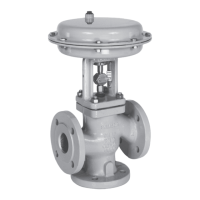16 EB 8026 EN
Design and principle of operation
Actuator stem retracts (FE)
When the signal pressure is reduced or the
power supply fails, the springs move the ac-
tuator stem upward, closing port A in the
mixing valve or port B in the diverting valve.
The actuator's direction of action can be re-
versed, if required. Refer to the mounting
and operating instructions of the pneumatic
actuator:
uEB8310‑X for Type3271 and Type3277
3.2 Versions
The modular design allows an insulating sec-
tion or bellows seal to be tted to the stan-
dard valve version.
Actuators
In these instructions, the preferable combina-
tion with a Type3271 or Type3277 Pneu-
matic Actuator is described. The pneumatic
actuator (with or without handwheel) can be
replaced by another pneumatic actuator in a
different size, but with the same travel.
Î Observe the maximum permissible actu-
ator force.
If the travel range of the actuator is larger
than the travel range of the valve, the spring
assembly in the actuator must be preloaded
so that the travel ranges match. See associ-
ated actuator documentation.
The basic pneumatic actuator can be re-
placed by a pneumatic actuator with addi-
tional handwheel or by an electric actuator.
3.3 Technical data
The nameplates on the valve and actuator
provide information on the control valve ver-
sion. See section2.1 and the actuator docu-
mentation.
More information is available in Data Sheet
uT8026.
Compliance
The Type3244 Valve bears both the CE and
EAC marks of conformity.
Temperature range
Depending on the version, the control valve
is designed for a temperature range from
–10 to +220°C (14 to 428°F). The use of
an insulating section or bellows seal extends
the temperature range from –196 to
+450°C (–325 to +842°F).
Noise emission
SAMSON is unable to make general state-
ments about noise emission as it depends on
the valve version, plant facilities, and pro-
cess medium.
Tip
Note
Note

